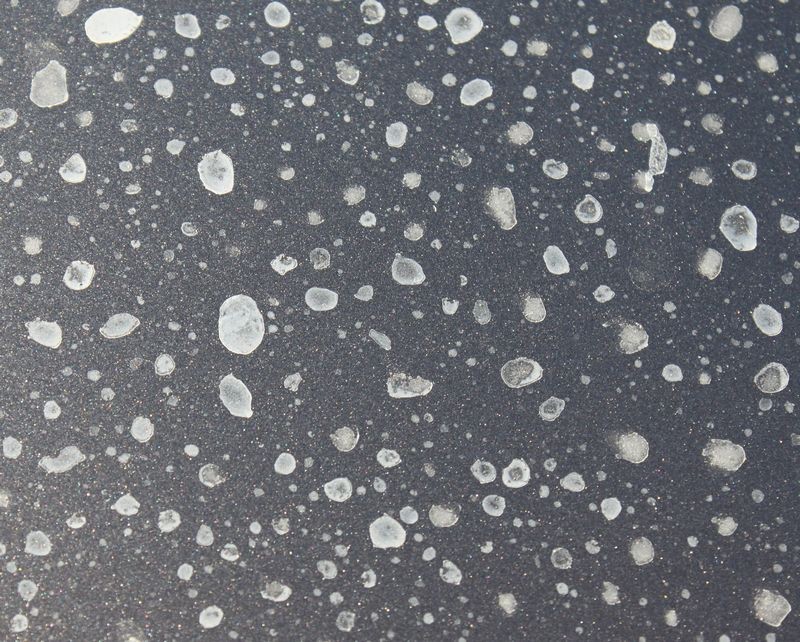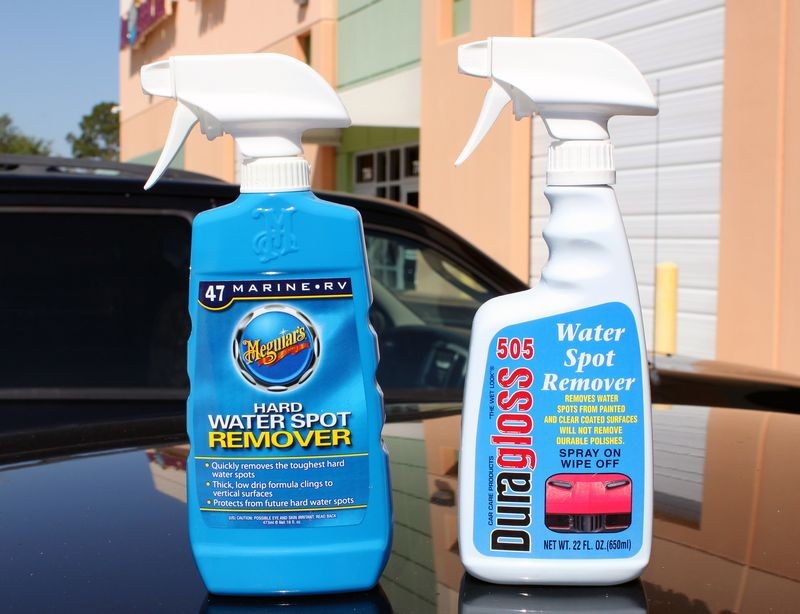Mike Phillips
Active member
- Dec 5, 2022
- 51,004
- 6
Using Vinegar to remove water spots
Vinegar
A common recommendation for removing water spots is to wipe the paint with vinegar, they kind you find in a kitchen pantry. If the water spots are in fact mineral deposits sitting on the top of the paint then this may work but you won't know until you try.
How Vinegar Works - (If and when it works)
Common cooking vinegar or food grade vinegar is a weak form of acetic acid, which is has low pH. Mineral deposits are just that, minerals that are either dissolved in water or embodied in water and when the water evaporates it leaves the physical mineral behind on the surface.
There are different types of minerals in water but one of the most common is Calcium Hydroxide. Calcium Hydroxide has a high pH, if the mineral deposits on your car's paint are Calcium Hydroxide, then the low pH Acetic Acid in the Vinegar will act to neutralize the high pH of the Calcium Hydroxide and either dissolve the minerals or break their bond to the paint and at that point you would be able to wipe them off the surface.
If the hard water spots are some other type of mineral deposits, then there's a good chance the acetic acid in the vinegar will have no effect and in a worse case scenario cause more harm than good. This is why in the forum world you'll often read accounts from some people where they share how great vinegar worked for them in their situation but then you'll read accounts by other people where the vinegar had no effect.
The problem with using Vinegar is that the acetic acid will act to remove any wax or paint sealant previously applied to the paint, wiping a waxed finish with vinegar certainly won't add more protection and what's the opposite of adding?
The other problem with using vinegar is that in and of itself it doesn't provide any extra lubricating ability outside of being a liquid. So using it with some type of cloth, for example a microfiber towel will not be as gentle as using a product formulated by a chemist specifically to be wiped over polished finish. And if fact if there are physical minerals on the surface then wiping them off without some type of added lubricity could in fact lead to scratching of the finish.
The two products show above, Duragloss 505 and Meguiar's M47 are manufactured by reputable companies and I'm confident the chemists have taken into account everything involved with creating a product for Joe Consumer to potentially wipe a clear coated finish to remove mineral deposits.
Remember clear coat paints are scratch-sensitive, that is they scratch easily. I think it's safe to assume that any product created by a reputable company for wiping off mineral deposits will include both lubricating agents plus glossing agents along with their proprietary ingredients for forcing the minerals to release their bond to the surface.
Key Benefits
The lubricating agents help prevent potential scratching from the minerals on the surface and the glossing agents restore a just detailed look to the finish.
These two included features to the products are important to car owners even thought most car owners probably don't even know they want and need these benefits from the product.
Vinegar offers neither of these benefits.
My recommendation
If you find you have what I call Type I Water Spots, that is what the world generically refers to as Hard Water Spots or Mineral Deposits, then obtain one of the two products listed in this article, especially if the spotting is an ongoing problem and give them a try. Other safe options would be to try a spray detailer, (at least it offers lubricating and glossing features), or try washing the car using a high lubricity car wash.
If you do opt to try vinegar, test first to a small area. Dampen a clean, soft microfiber towel with vinegar, place it on the affected area and allow it to remain for a few seconds so it can soften and hopefully dissolve the mineral deposits, then gently wipe the surface. This would be a safer approach then wiping dry paint with dry mineral deposits bonded to the surface.
Important
If you use vinegar to remove water spots, plan on re-applying some type of wax or paint sealant afterwards to restore any protection removed from the acetic acid.

Water Spots
 s
s

Vinegar
A common recommendation for removing water spots is to wipe the paint with vinegar, they kind you find in a kitchen pantry. If the water spots are in fact mineral deposits sitting on the top of the paint then this may work but you won't know until you try.
How Vinegar Works - (If and when it works)
Common cooking vinegar or food grade vinegar is a weak form of acetic acid, which is has low pH. Mineral deposits are just that, minerals that are either dissolved in water or embodied in water and when the water evaporates it leaves the physical mineral behind on the surface.
There are different types of minerals in water but one of the most common is Calcium Hydroxide. Calcium Hydroxide has a high pH, if the mineral deposits on your car's paint are Calcium Hydroxide, then the low pH Acetic Acid in the Vinegar will act to neutralize the high pH of the Calcium Hydroxide and either dissolve the minerals or break their bond to the paint and at that point you would be able to wipe them off the surface.
If the hard water spots are some other type of mineral deposits, then there's a good chance the acetic acid in the vinegar will have no effect and in a worse case scenario cause more harm than good. This is why in the forum world you'll often read accounts from some people where they share how great vinegar worked for them in their situation but then you'll read accounts by other people where the vinegar had no effect.
The problem with using Vinegar is that the acetic acid will act to remove any wax or paint sealant previously applied to the paint, wiping a waxed finish with vinegar certainly won't add more protection and what's the opposite of adding?
The other problem with using vinegar is that in and of itself it doesn't provide any extra lubricating ability outside of being a liquid. So using it with some type of cloth, for example a microfiber towel will not be as gentle as using a product formulated by a chemist specifically to be wiped over polished finish. And if fact if there are physical minerals on the surface then wiping them off without some type of added lubricity could in fact lead to scratching of the finish.
The two products show above, Duragloss 505 and Meguiar's M47 are manufactured by reputable companies and I'm confident the chemists have taken into account everything involved with creating a product for Joe Consumer to potentially wipe a clear coated finish to remove mineral deposits.
Remember clear coat paints are scratch-sensitive, that is they scratch easily. I think it's safe to assume that any product created by a reputable company for wiping off mineral deposits will include both lubricating agents plus glossing agents along with their proprietary ingredients for forcing the minerals to release their bond to the surface.
Key Benefits
The lubricating agents help prevent potential scratching from the minerals on the surface and the glossing agents restore a just detailed look to the finish.
These two included features to the products are important to car owners even thought most car owners probably don't even know they want and need these benefits from the product.
Vinegar offers neither of these benefits.
My recommendation
If you find you have what I call Type I Water Spots, that is what the world generically refers to as Hard Water Spots or Mineral Deposits, then obtain one of the two products listed in this article, especially if the spotting is an ongoing problem and give them a try. Other safe options would be to try a spray detailer, (at least it offers lubricating and glossing features), or try washing the car using a high lubricity car wash.
If you do opt to try vinegar, test first to a small area. Dampen a clean, soft microfiber towel with vinegar, place it on the affected area and allow it to remain for a few seconds so it can soften and hopefully dissolve the mineral deposits, then gently wipe the surface. This would be a safer approach then wiping dry paint with dry mineral deposits bonded to the surface.
Important
If you use vinegar to remove water spots, plan on re-applying some type of wax or paint sealant afterwards to restore any protection removed from the acetic acid.
